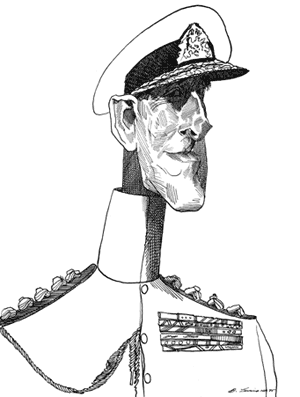One of the deadliest traps for the writer of contemporary history is the informant who is just too good. A central actor in the events to be chronicled, crisp and comprehensive in memory, meticulous in preserving his documents, forthcoming, articulate, immensely likable to boot—when these authors found such an informant across the French ambassador’s table in London, they must have felt that their intended work on the independence and partition of India was already almost done, and safely on the best-seller lists. Lord Mountbatten, the last of the viceroys, who was sent to India to set it free, and stayed on as independent India’s first governor-general, gave Mr. Collins and Mr. Lapierre some thirty hours of tape-recorded interviews. The authors claim that this amounted to “the most painstaking and exhaustive review of his Indian experiences that he has ever been exposed to,” remarking that during this process Lord Mountbatten was able to refer constantly to the documents in his possession. And there’s the rub. It was not the authors who consulted the crucial documentation, but the former viceroy.
The result is not only that Lord Mountbatten’s judgments, decisions, and actions are described in great detail—they would have to be in any history of this momentous act of imperial demission—but that Mountbatten both fills the stage and dominates the audience. The point of view is his throughout. Freedom at Midnight gives us Mountbatten’s version of the drama of Britain’s relinquishment of her Indian empire, with supporting voices that turn what might have been a vivid aria into an oratorio.
That the authors responded wholeheartedly to Lord Mountbatten is clear throughout their narrative. They make his likes and dislikes their own. Nehru, Gandhi (the secondary hero), and indeed the whole approach of the Congress party to independence and partition are treated with respect and affection; when criticism is voiced it is compassionate, never harsh. Their villain, too, is Mountbatten’s. “The evil genius of the whole thing,” “a psychopathic case,” “hellbent” on his “exigent demand” for Pakistan—that is how Mountbatten described the Moslem League leader Mohammed Ali Jinnah to the authors and that, more or less, is how they depict him. It is a subjective and shallow appreciation of Jinnah and reveals a gross underestimation and misunderstanding of the historical and social forces that brought about partition.
The very intensity of Mountbatten’s antipathy for Jinnah and opposition to his cause is among the few new insights that emerge from this long book. It demonstrates how right Jinnah was in his belief that Mountbatten was never neutral between him and the Congress party; and how well founded was Jinnah’s (and Pakistani) suspicion that under Mountbatten’s aegis the Indians obtained many concessions that tilted the advantage in the terms of partition even more in their favor than did factors of geography and economics.
Mountbatten conceived the idea that once partition and the double independence—India from Britain, Pakistan from India—had been achieved, he should continue as a stabilizing force in the subcontinent by becoming common governor-general to both new states. His offer was enthusiastically welcomed by Congress, but Jinnah turned him down cold. That decision is represented in this book as providing further evidence of Jinnah’s negative obstinacy, and little effort is made to give his side. Quite apart from the very good grounds Jinnah already had by then to distrust Mountbatten’s impartiality, all the great disparities between India and Pakistan would inevitably have meant that Pakistan’s share of Mountbatten’s attention, as of everything else, would have been at least proportionately low. The intriguing question is not really why Jinnah turned down Mountbatten’s proposal (the enthusiasm with which Congress welcomed it might almost have been enough in itself to warn Jinnah off the idea), but rather whether the idea of being common governor-general having been nullified by Jinnah’s refusal, Mountbatten should have persisted in continuing as governor-general of India alone.
That question these authors do not pursue. Nor do they press the other central question that historians, fairly, ask: was Mountbatten right in advancing the date of independence by some ten months? Was this “awful haste,” as the authors rightly describe it, to accomplish the withdrawal of British power, and the sundering of what they had ruled as one, unavoidable in the circumstances of 1947? Was it the lesser evil? Or did the rush to leave India merely intensify the stress of partition, creating chaos and incapacitating the established administration on the subcontinent from controlling and suppressing the dreadful massacre and carnage that in the event marked the withdrawal of British power? Ultimately those questions may be unanswerable, but that does not mean they can be ignored. The authors’ implicit assumption that the decision to rush was right because Mountbatten took it is not acceptable.
Advertisement
In their account of Mountbatten’s role, the authors offer some new disclosures, but they are more piquant than significant. Immediately after independence, for example, Mountbatten, now governor-general of India, retired to the cool of the hills to rest. The authors show that he was summoned urgently back to Delhi where the new men in power, Nehru and Patel, humbly begged him to take over again, confessing that they lacked the drive and administrative experience to avert the impending chaos. Perhaps more striking is a disclosure about Gandhi’s last fast. According to this account Gandhi told Mountbatten that he intended to undergo another fast, not to be broken this time until the warring Hindu and Muslim communities of Delhi stopped their reciprocal slaughter and made peace. Mountbatten thereupon proposed that Gandhi attach a further demand to his fast. The new Indian government was then reneging on its obligation to pass over to Pakistan a sum equivalent to $160 million, and Mountbatten suggested that Gandhi use the moral leverage of his fast to force his Congress colleagues to pay up.
That this was Mountbatten’s idea was not previously known. Gandhi did make India’s transfer of Pakistan’s funds a condition of ending his fast, and the Congress government paid up rather than have Gandhi’s death on its conscience. Here Mountbatten threw his weight in favor of Pakistan (and to save his friends in Delhi from blemishing their infant record with an act of what the authors call “international embezzlement”); but it was Gandhi’s insistence on this very point that made his assassins decide to kill him.
The authors treat Gandhi in the conventional mode of hagiography and, as usual, the approach leads to distortion of the historical record. Again, the authors make Lord Mountbatten’s view their own. Mountbatten tells a friend that Gandhi “will go down in history on a par with Buddha and Jesus Christ,” and the authors duly entitle their chapter on Gandhi’s assassination “The Second Crucifixion”—without inverted commas. They suggest throughout that Gandhi brought about Britain’s surrender of her Indian empire by almost single-handed moral force. They do not explore those elements of Gandhi’s style that led the usually mild and charitable Lord Wavell (Mountbatten’s predecessor as viceroy) to describe him as “a malevolent old politician…shrewd, obstinate, domineering, double-tongued…with little true saintliness in him.”
The authors do, however, take note of and illustrate Gandhi’s quirkiness, especially in his attitudes to sex. Unlike most of Gandhi’s biographers, they are explicit about what is often described as his darkest hour, a moment of horror and extreme spiritual suffering, leading to weeks of self-punishing muteness on Gandhi’s part, and a profound pall of gloom over all the inmates of the ashram where this calamity occurred: Gandhi, at the age of sixty-seven, had woken in the night with an erection. Gandhi’s attitudes to sex were traditionally Hindu. If the authors had been able to recognize this, they might have interpreted his expressions, political and ethical as well as sexual, as within the Hindu tradition.
Like so many others who write about Gandhi, Collins and Lapierre greatly exaggerate his achievements. At one point they go so far as to say that Gandhi’s death ended communal killings in India forever, which is an absurdity. That and the claim that with his teachings Gandhi “changed the face of India” suggest that on their travels in India researching this book their concern with the past blinkered them to the realities of the present. In India one can look far and wide without finding any trace of Gandhian influence on public or private life today, apart from a few hollow observances and the irrelevancies of a tiny residue of followers. The authors make much of Gandhi’s actions in the cause of India’s untouchables, ignoring the fact that the greatest of the untouchable leaders, Ambedkar, dismissed Gandhi as “a successful humbug” whose actions worked consistently against the political interest of the untouchable castes. Today at last there are signs that the untouchables are stirring into resistance against their ancient oppression. The evidence lies in Indian government figures showing a dramatic, continuing increase in the frequency and ferocity of acts of repression and atrocity visited upon them.
Beyond the two prime distortions in this book, the heightening of the statures of both Gandhi and Mountbatten that comes from looking at them from bended knee, so to speak, there are numerous errors of detail. Perhaps these are inevitable in a work which builds up its powerful effect by the multiple accumulation of small touches, and so to list them would be carping. But as examples it might be noted that the Gateway of India, a monumental arch on the waterfront of Bombay, was never used by citizen travelers like Gandhi but only by such potentates as arriving and departing viceroys. Nehru was not prime minister of the interim government in the months before independence—there was not, and could not have been, any prime minister in that government.
Advertisement
One’s disappointment in Freedom at Midnight arises from the failure of the authors to derive from their diligent and far-ranging researches any really fresh perceptions. No one who already has some detailed knowledge of the events chronicled will learn more than additional details, and most of these are themselves trivial.
For those who are almost entirely uninformed on the subject, and are not seriously interested in history, the book will not be disappointing. The cinematic style, including flashes back and forward, and cuts from epic panoramas to clinical close-ups of people caught in the historic turmoil of the time, is disciplined by a firm, clear narrative. The prose is rich, sometimes lush, and the book is as readable as those popular novels in which fiction is mixed with a painstakingly researched factual account. The authors are particularly skillful in telling how the plot to assassinate Gandhi was first conceived and how it was botched before it finally succeeded.
This Issue
December 11, 1975




